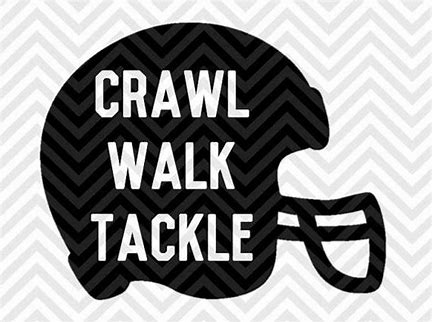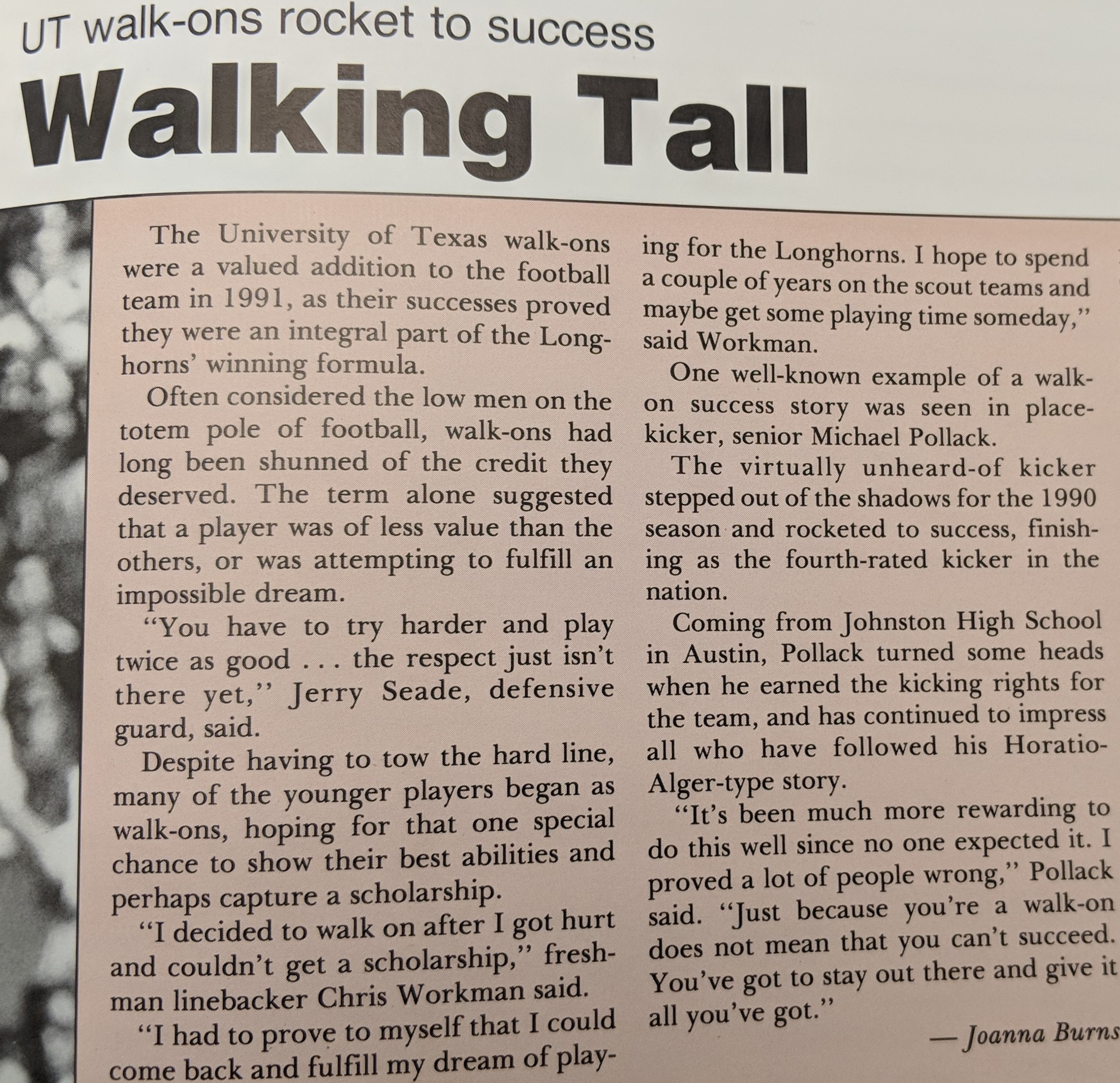The Walk-on
Social validation is tied to being part of a college team for men and women. Walk-ons embody the purity of the activity playing for principles and personal motives.
Walk-ons are the closest to the ideal of a pure amateur college athlete. The student asked their coach to try out and play without financial compensation.
Mickey Moss is a successful coach and administrator who received a master's degree from the University of Texas at Austin in athletic administration, emphasizing exercise physiology. Walk-ons should heed his advice “goals are good, but without a system of practiced habits in place, goals alone will not lead to success.”
xxxxxxxxxxxxxxxxxxxxxxxxxxxxxxxxxxxxxxxxxxxxxxxxxxxxxxxxxxxxxxxxxxxxxxxxxxxxxxxxxxxxxxxxxx
In late February of 2019, I contacted Rick Allen and asked him about the origin of the college football term “walk-on” and the origin of the term “preferred walk-on.” His comments follow:
Hi Billy,
The NCAA has allowed walk-ons since the organization began. We know this because there aren't, and never have been, enough scholarships for every team member at each university.
The term "preferred" walk-on is a term made up by the college coaches and only means whatever that coaching staff wants it to mean. You won't find the term "preferred walk-on" in the NCAA rules or terminology.
“They (a walkon) will always be needed because they give coaches plenty of bodies to practice with, and plenty of scout-team players to simulate other team's offense, defense, and sets."
At one school, 'preferred' might mean you have a guaranteed spot for a year, but at another, it might mean that while you don't have to go through an open tryout, there's still no roster guarantee.
Another distinction is that Division I walk-ons deemed to have been recruited who then want to transfer to another Division I school must sit out a year, just like scholarship players.
Rick
Rick Allen
Founder - Informed Athlete
Office: 913-766-1235
www.informedathlete.com
rick@informedathlete.com
"Making Sense of the Complex NCAA, NAIA, and NJCAA Rules"
- 25+ years NCAA Rules Expertise, including Director of Compliance at 2 major DI schools
- Member and Former President of the National Association for Athletic Compliance
- Conducts compliance reviews and audits for NCAA schools throughout the US
- Has consulted with NAIA schools transitioning to NCAA DII membership
- Parent of a former DI and II baseball player
xxxxxxxxxxxxxxxxxxxxxxxxxxxxxxxxxxxxxxxxxxxxxxxxxxxxxxxxxxxxxxxxxxxxxxxxxxxxxxxxxxxxx
If you want to walk-on at Texas, you may do so only if you qualify as an incoming UT freshman. This means you have to be in the top 8% of your graduating class or post an exceedingly high test score on the college entrance exam.
Reggie White from the Philadelphia Eagles once said, always dream big and reach for the stars because even if you miss, you will still be among the stars. A walk-on should set a goal of starting, not just making the team. Gary Brackett says, "we can only rise to the level of our expectations."
It is important to have loved ones who believe in you. That catalyst will eventually be the key to believing in yourself.
Failure is the beginning, not the ending of a quest. At some point, a walk-on must understand that attitude can be more important than skills. Players who understand that failure is a learning experience and a path to success have a better chance of making the team.
Walk-ons should also understand that it may be a subtle moment instead of blaring horns when opportunity knocks. So prepare yourself for the opportunity of winning as a walk-on by listening with your heart, not your head. Do NOT depend on anyone but yourself to seize the moment when it arrives, and know that if you do not seize it immediately, someone else will.
The movie "Rudy" is a heartwarming inspirational movie about a young man who is small and slow who walks-on at Notre Dame, and in his final game, experiences a moment of glory. If your only motivation to walk-on is this movie, then don't bother. What most dreamers of glory don't remember about the film is the years of hard work Rudy endured to celebrate this one moment.
History is replete with walk-ons who cannot adjust to the ugly side of trying to make the team as a non-scholarship athlete. Going to classes and staying motivated on the practice field is difficult, and most will not succeed. Making the team, even the practice squad, is difficult. According to WVU's Dorchester, about 70 walk-ons try out for their team every year, and only five are invited to the practice squad.
A WALK-ON MUST UNDERSTAND THAT EVERYDAY AT PRACTICE IS GAME DAY FOR THEM, AND THE ONLY KEY TO SUCCESS IS WINNING THE GAME EVERY DAY.
The first to quit are walk-ons who are only motivated by glory instead of the game's spirit.
Training must be tolerated and accepted as part of the process to reach a goal. Carl Vergari was a Texas walk-on his senior year who loved the spirit of the game. He said, "I love the game." "It wasn't about playing time. I just loved being part of a team." From my personal experience playing for the Longhorns, you can love the game and the team bond without enjoying the practice. Players who love practice- running sprints, participating in agility drills, lifting weights, yelling from the coaches, and brutal contact- are a little strange.
“You can’t put a stopwatch on heart or determination,” Tim Lavin.
Even if a walk-on loves the game and tolerates practice, the athlete still needs some talent and luck to make the team. Coaches select the team members based on need, not necessarily ability. A great walk-on running back will probably not make the team if the two-deep for Texas is Ricky Williams and Priest Holmes.
Walk-on's and their parents must also understand and accept an unspoken hierarchy in selecting team members. Since Coaches are graded on the success or failure of athletes who get a "full-ride," they will focus their coaching skills on the scholarship players first. There is also an unspoken rule that if two players with equal talent walk-on and one is a "legacy" longhorn (one whose father or brother has brought honor to the Longhorn nation), he will be chosen to join the team.
Walk-ons must accept that they will be treated differently from the scholarship athletes.
In his book Winning, Gary Brackett says that walk-ons need to prepare to "get fewer chances and less leeway for mistakes." As a walk-on, Gary Brackett says, " I embraced my walk-on mentality and tried to do more with less."
In his book Walk-on U written in 2013, Tim Lavin warns walk-ons to be prepared to be "ignored, valued but scorned, and encouraged but held back. "Walk-ons are not regular people." He says that as walk-ons, they will "experience a lifetime of emotions during just a few short years." Tim Lavin says that Walk-ons are a victim of the system. "Internally, the coaches think differently about you, players don't treat you equally, and you walk on eggshells with every step you take and every move you make." Get used to being a tackling dummy and cannon fodder for the scholarship players.
Late 1950’s to 1964.
Tommy Lucas says about playing for the Longhorns in the early 60's "There were 96 in the team picture of my freshman year of 1959, and not all of them were scholarship players! There were no NCAA scholarship limits in those days, so colleges could give as many as their athletic department could afford. Most schools gave what was called a partial scholarship…. The scout team was made up mostly of these kinds of players, and they practiced on a different field away from the top 3 varsity teams. Of the 96 in the freshman class football picture, only 13 of us left my senior year of 1962. Many of the 96 were grade casualties, and others transferred to other schools to make the team.
1967
There are two walk-on stories about the 1967 team. 1967 was one of the first years that football scholarships were limited to 50 by the NCAA. As Tommy Lucas says about the early 1960s, "there were no scholarship limits." The days of offering partial scholarships to many players to keep them from playing for a competitor were gone. In 1967 the Texas freshman class had 45 signed scholarship athletes and 13 walk-ons competing for those five open scholarships, but only two were earned - Stan Mauldin and Happy Feller. By this class's senior year, there were still 28 of the 58 freshmen remaining. These 28 were known as the "Worster Bunch," and these athletes won two national championships, three Conference Championships, and played in every game of the 30 game win streak.
1967 recruiting class







